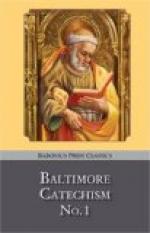Lord’s agony. He allowed them to see the
Transfiguration, so that when they should see Him suffering
as man, they would remember that they saw Him on the
mountain glorified as God. (2) Agility; that is, a
glorified body can move rapidly from one place to
another, like the lightning itself. After His
resurrection Our Lord was in Jerusalem, and almost
immediately He appeared near the village of Emmaus
to two disciples going there. (Luke 24). They
had left Jerusalem after the Crucifixion, probably
through fear, and were going along together talking
about what had happened during the days of Our Lord’s
Passion. Suddenly Our Lord came and walked and
talked with them, but they did not know Him.
They asked Him to stay that night at their house,
for it was growing dark. He did not stop with
them, and at supper they knew Him, and then He vanished
from their sight. An ordinary person would have
to get up and walk away; but He vanished, showing on
this occasion the second quality of His glorified
body—agility. (3) Subtility; that is, such
a body can go where it pleases and cannot be resisted
by material things. It can pass through closed
doors or gates, and even walls cannot keep it out.
It passes through everything, as light does through
glass without breaking it. At one time after Our
Lord’s resurrection the Apostles were gathered
together in a room, for they were still afraid of
being put to death, and the doors were tightly closed.
Suddenly Our Lord stood in the midst of them and said:
“Peace be to you.” (John 20:19).
They did not open the door for Him; neither wood nor
stone could keep Him out: and thus He showed that
His body had the third quality. (4) His body had the
fourth quality also—impassability, which
means that it can no longer suffer. Before His
death, and at it, Our Lord suffered dreadful torments,
as you know; but after His resurrection nothing could
injure or hurt Him. The spear could not hurt
His side, nor the nails His hands, nor the thorns His
head. Shortly after His resurrection Our Lord
appeared to His Apostles while Thomas, one of them,
was absent. (John 20:24). When Thomas returned,
the other Apostles told him that they had seen the
Lord risen from the dead; but he would not believe
them, saying: “Unless I see the holes where
the nails were in His hands and feet, and put my finger
into His side, I will not believe.” Now
Our Lord, knowing all things, knew this also; so He
came again when Thomas was present, and said to him:
“Now, Thomas, put your hand into My side.”
Thomas cried out: “My Lord and my God!”
He believed then, because he saw. Now if this
body of Our Lord’s had been an ordinary body,
it would have caused Him pain to allow anyone to put
his hand into the wound; but it was impassable.
It seems very strange, does it not, that Thomas would
not believe what the other Apostles told him?
God permitted this. Why? Because, if they
all believed easily, some enemies of Our Lord might
say the Apostles were simple men that believed everything




